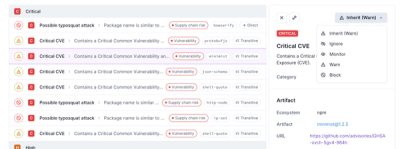
Research
Security News
Malicious npm Package Typosquats react-login-page to Deploy Keylogger
Socket researchers unpack a typosquatting package with malicious code that logs keystrokes and exfiltrates sensitive data to a remote server.
@slack/client
Advanced tools
Readme
Read the full documentation for all the lovely details.
So you want to build a Slack app with Node.js? We've got you covered. {{ site.product_name }} is aimed at making building Slack apps ridiculously easy. This module will help you build on all aspects of the Slack platform, from dropping notifications in channels to fully interactive bots.
This is a wrapper around the Slack RTM and Web APIs.
This library provides the low level functionality you need to build reliable apps and projects on top of Slack's APIs. It:
This library does not attempt to provide application level support, e.g. regex matching and filtering of the conversation stream.
Most Slack apps are interested in posting messages into Slack channels, and generally working with our Web API. Read on to learn how to use {{ site.product_name }} to accomplish these tasks. Bots, on the other hand, are a bit more complex, so we have them covered in Building Bots.
All of these examples assume that you have set up a Slack app or custom integration, and understand the basic mechanics of working with the Slack Platform.
Incoming webhooks are an easy way to get notifications posted into Slack with a minimum of setup. You'll need to either have a custom incoming webhook set up, or an app with an incoming webhook added to it.
var IncomingWebhook = require('@slack/client').IncomingWebhook;
var url = process.env.SLACK_WEBHOOK_URL || ''; //see section above on sensitive data
var webhook = new IncomingWebhook(url);
webhook.send('Hello there', function(err, res) {
if (err) {
console.log('Error:', err);
} else {
console.log('Message sent: ', res);
}
});
You'll need a Web API token to call any of the Slack Web API methods. For custom integrations, you'll get this from the token generator, and for apps it will come as the final part of the OAuth dance.
Your app will interact with the Web API through the WebClient object, which requires an access token to operate.
var WebClient = require('@slack/client').WebClient;
var token = process.env.SLACK_API_TOKEN || ''; //see section above on sensitive data
var web = new WebClient(token);
web.chat.postMessage('C1232456', 'Hello there', function(err, res) {
if (err) {
console.log('Error:', err);
} else {
console.log('Message sent: ', res);
}
});
Starting a bot up requires a bot token (bot tokens start with xoxb-),
which can be had either creating a custom bot or by creating an app with a
bot user, at the end of the OAuth dance. If you aren't sure path is right for you,
have a look at the Bot Users documentation.
var RtmClient = require('@slack/client').RtmClient;
var CLIENT_EVENTS = require('@slack/client').CLIENT_EVENTS;
var bot_token = process.env.SLACK_BOT_TOKEN || '';
var rtm = new RtmClient(bot_token);
// The client will emit an RTM.AUTHENTICATED event on successful connection, with the `rtm.start` payload if you want to cache it
rtm.on(CLIENT_EVENTS.RTM.AUTHENTICATED, function (rtmStartData) {
console.log(`Logged in as ${rtmStartData.self.name} of team ${rtmStartData.team.name}, but not yet connected to a channel`);
});
// you need to wait for the client to fully connect before you can send messages
rtm.on(CLIENT_EVENTS.RTM.RTM_CONNECTION_OPENED, function () {
rtm.sendMessage("Hello!", channel);
});
rtm.start();
FAQs
Unknown package
The npm package @slack/client receives a total of 55,364 weekly downloads. As such, @slack/client popularity was classified as popular.
We found that @slack/client demonstrated a not healthy version release cadence and project activity because the last version was released a year ago. It has 4 open source maintainers collaborating on the project.
Did you know?

Socket for GitHub automatically highlights issues in each pull request and monitors the health of all your open source dependencies. Discover the contents of your packages and block harmful activity before you install or update your dependencies.

Research
Security News
Socket researchers unpack a typosquatting package with malicious code that logs keystrokes and exfiltrates sensitive data to a remote server.

Security News
The JavaScript community has launched the e18e initiative to improve ecosystem performance by cleaning up dependency trees, speeding up critical parts of the ecosystem, and documenting lighter alternatives to established tools.

Product
Socket now supports four distinct alert actions instead of the previous two, and alert triaging allows users to override the actions taken for all individual alerts.